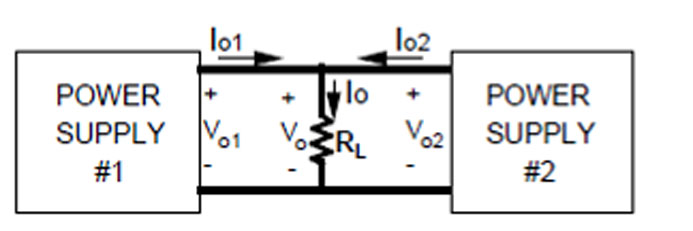What is Current Sharing?
Current sharing is the technique in which power supplies are connected in parallel to provide more load current or redundant power to a load. This connection increases the amount of current available for the load while the voltage remains constant.
Current sharing is used for three main reasons
- To increase available load current
- Minimize power bus glitches which may occur when a supply has failed, or on sensitive loads which requires power redundancy or fault tolerance
- Enables de-rating of the power supplies and hence improves their reliability
When sharing current between two or more supplies, some requirements must be met to avoid overloading or damage to some of the power units.
- A current sharing control mechanism must be used to share the load proportionally
- Another requirement is the Oring Diodes which ensures that none of the modules will sink current from the other and isolation of the modules in case of a failure
The current sharing requires carefully selected power supplies. The modules may be similar or not, however considerations are made to ensure that the load is shared proportionally, although not necessarily equally. If care is not taken the module with more power may be driven to deliver its maximum rated current and sometimes beyond. A situation which can lead to overloading and temperature stresses which can spoil the module.
Current Sharing methods
The three main methods are:
- Brute-force
- Forced – also referred to as Active or Third wire current sharing
- Zero wire – also referred to as passive sharing, droop regulation or slope programming
Most switching power supplies, whether standard or custom, provide support for the three current sharing methods.
Brute-Force current sharing
It is the simplest current sharing method where two or more parallel supplies are connected together at the load. It does not use any additional control circuitry to balance the loading among the power supplies.
Pros
- Scalable
- Can use ordinary power supplies
- Inexpensive
- Flexible
Cons
- Potential of overstressing the supplies
- Precisions adjustments of the output voltages are required
The output conductor gauge, length and connections should be closely matched
Forced Current Sharing
Uses an active circuitry and measure and compare the supply’s output current with those from other parallel power supplies. A third wire is used to connect the supplies. The active sharing circuitry provides a feedback that controls the pulse width modulators which in turn adjust the output voltage.
Pros
- Load is shared evenly
- Has the best voltage regulation within +/- 1%
- Good scalability
- Can be sensed remotely
Cons
- Complex design, expensive and does not work on power supplies from different vendors or series
- The third wire may require an external noise reduction circuit
Zero wire – (passive sharing, droop regulation or slope programming)
The Zero wire is a simple and reliable current sharing method. The power supply circuitry measures its output current and adjusts its voltage either up or down. If the load current increases the voltage decreases linearly.
Pros
- Better load balance
- Simple and Inexpensive
- reliable
- Excellent scalability
- No adjustments
Cons
- Lower voltage regulation of about +/- 2%
Advantages of current sharing
- Improves fault tolerance, load current
- Allows de-rating hence longevity of all the power supplies
- The current sharing helps to keep all the power modules ‘awake’ with some amount of current flowing, as opposed to keeping them asleep
